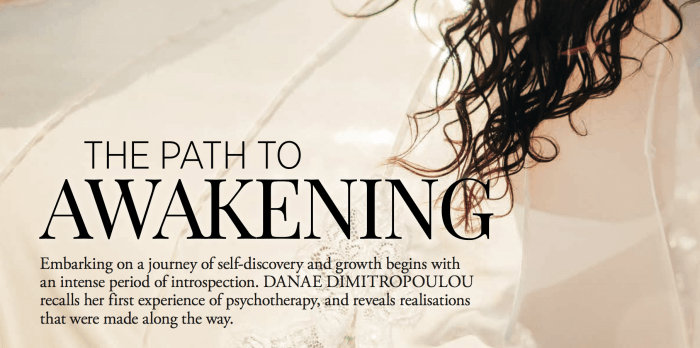
27 Nov The Path to Awakening
It was a crisp autumn night when I pulled up outside a niche art gallery in the heart of Collingwood in Melbourne. I sat in my car for a few moments, inspecting the space where I’d spend the weekend partaking in the Awakening of Love retreat – an introduction to Path of Love, a seven- day retreat that’s held in 14 countries around the world. As I walked towards the door, a mixture of apprehension and uncertainty washed over me. As I stepped inside the gallery, my fear immediately subsided as I was greeted with a warm welcome from Gina Bloom, a psychotherapist, counsellor and somatic experience practitioner.
Bloom invited me to make a cup of herbal tea, pull up a chair and sit with the rest of the group. I joined the small circle and quickly scanned the other participants’ faces. I was met with a few smiles, some quick glances and polite small talk. I could feel the nervous energy and uncertainty in the air, so I turned my attention inwards and focused on my breath.
We were soon joined by Samved Dass, a psychotherapist with training in bioenergetics, counselling and Osho’s transformational therapies. Dass has worked as a Path of Love leader for more than 14 years, and he passionately advocates the course’s ability to effect profound change in peoples’ lives. “Path of Love is one of the most significant and effective pieces of enquiry work that you can do,” says Dass. “It’s not a new-age, fluffy piece of work; it’s a very substantial enquiry in a group setting that has profound results in your life.”
After a brief introduction, Bloom and Dass encouraged each participant to embrace the process with an open heart. We were then invited to share what we hoped to get out of the experience. Everyone expressed a unique objective, but it was clear that we had one unifying trait: the human longing to understand the self, work through past traumas and experience joy in the present moment.
DAY 1
Many of the exercises implemented in the retreat are designed to get us out of our minds and connecting with the body. “We use current psychology approaches to bring together East and West,” says Bloom. “There are a lot of meditations and spiritual teachings about being in presence, rather than trying to ‘solve problems’ and figuring them out with the mind.
“Path of Love is very structured; it’s designed in a way that really opens people up and builds trust and safety, to be able to explore very deep issues,” says Bloom.
For our first exercise, we were instructed to walk around the room, without talking, and exchange eye contact with the other participants. I found this exercise both amusing and uncomfortable, but I remembered what Dass said about releasing into the process, and let myself settle into the uncertainty.
For the next exercise, we were instructed to sit in a long line against the wall, and one by one, in no particular order, we were asked to stand up in front of everyone and maintain eye contact, without speaking, for one full minute. I didn’t anticipate the effect this would have on my body. Instantly, I was flooded with nerves and the realisation that I was truly being seen by these people. For once, there was nowhere to hide. There was nothing to do other than stand and gaze into the eyes of the perfect strangers I’d just met.
For some, this exercise was profoundly challenging, which resulted in tears and the inability to maintain eye contact, while others channelled their vulnerability and decided to face it head-on. We had only been in the studio for two hours, and already I had witnessed many emotional releases. I left the evening session feeling relieved to be back in my comfort zone. As I lay in bed that night, I considered – OK, I dreaded – what might await me in the morning.
DAY 2
The second day commenced with a chat about our experiences and impressions of the night before. Bloom and Dass encouraged us to be honest, and re-assured us that our opinions weren’t being judged. After, we entered into a Kundalini meditation. We stood in the room as the lights dimmed and the loud, drumming music started to echo through the speakers. Dass instructed us to slowly move the body and begin to shake. As time went on, the shake went deeper into the muscles, tissues and the bones.
Dass says that many issues that we hold from past hurts and traumas are manifested in the body, where they cause tension and tightness. Many of these can be opened and unlocked through movement, he says. “When we shake the body, we start to loosen up some of those places where we hold our tensions. When we loosen up in the body, we can more easily see the psychological aspects of where we’re holding the tension.”
For the next exercise, we gathered in groups of two, where one person was prompted to speak on a topic for five minutes and the other was instructed to listen – without speaking. This act enables us to express ourselves and be heard without judgement, which I learnt is a pertinent factor of self-enquiry.
“It’s a very substantial enquiry in a group setting that has profound results in your life.”
“By being able to start to talk, and having people listen and realise they’re not judging you, it enables the effects of the trauma to lessen – and sometimes completely disappear,” says Dass. “Then [your trauma] becomes something that happened in your past, and if you don’t judge it, the trauma of it disappears.”
After a one-hour lunch break, we gathered in groups of four, where childhood traumas, past regrets and memories were brought to light. “The main thing about reconciling hurts and pains – which we refer to as traumas – is being able to bring them out of the subconscious mind, which is where they’re often put when we’re children,” he says. “Unfortunately, because they’re in the subconscious/unconscious mind, it doesn’t mean they’re not acting on our psychology, on our psyche.” This particular exercise incited emotional shifts in all of the participants – myself included.
The day ended with a much-needed meditation in savasana, also known as corpse pose, or the pose you take at the end of a yoga class. While it’s thought to be one of the easiest asanas, it’s a fully conscious pose that aims to keep you awake, yet relaxed. It’s believed to calm the nervous system and eliminate tension from the body – something that’s deeply required after a long day of self-enquiry. With so much purging of raw emotion that happened throughout the day, the energy in the room felt heavy. As I headed home, I was struck with a thumping headache and an unexpected lack of energy. I felt emotionally and physically depleted, which Bloom and Dass later informed me can be part of the cleansing process.
DAY 3
I woke up the next morning feeling slightly tired but surprisingly refreshed. As I arrived at the art gallery, I joined the participants, who were once again sitting in a circle. We shared sentiments of the previous day, along with how we felt throughout the night. Interestingly, there were some profound shifts from the activities of the previous day. The sceptic in me was surprised, as I started to feel an opening and willingness to share my vulnerabilities with the group. According to Dass, this isn’t unusual, but rather a regular occurrence that results from this type of work.
“We call it an awakening because it awakens you to your inner process, to what’s actually going on,” he says. “Rather than just taking it [life] all for granted, we start to face the truth. When we face the truth, we really can take steps.”
The first exercise we undertook was the Kundalini shaking meditation, which led into our one-on-one enquiry exercises, where more realisations about the ego, suffering and judgement were brought to light. With the help of our facilitators, we learnt why we judge ourselves so harshly, and how it can stump our ability for growth.
“We apply judgement to our adult behaviour, which is not necessary, because we’re [now] grown up and intelligent and educated,” says Dass. “It makes it difficult to do any progressive work because we’re constantly making ourselves wrong. You can’t progress if you’re putting yourself down all the time.”
We concluded the retreat with a dancing meditation, a long savasana and a personal exchange with one of the facilitators, sharing our final thoughts and insights.
While I entered the retreat with a fair deal of trepidation and scepticism, I had experienced an undeniable shift in my awareness. With the guidance of both Bloom and Dass, I learnt how to witness my vulnerabilities, without attaching judgement to them. I was able to recognise the way past events informed my present-day thinking and actions, and I was able to deepen my practice of staying in presence. I carried that with me for several weeks after the retreat.
Looking back, I can see that awakening does not happen overnight, and that consistent growth requires sustained dedication to our inner work and enquiry. The Awakening of Love is just the beginning in my long journey towards self-realisation.
No names, information or stories expressed by the retreat participants were disclosed in this article. Danae Dimitropoulou was a guest of the Awakening of Love retreat.






